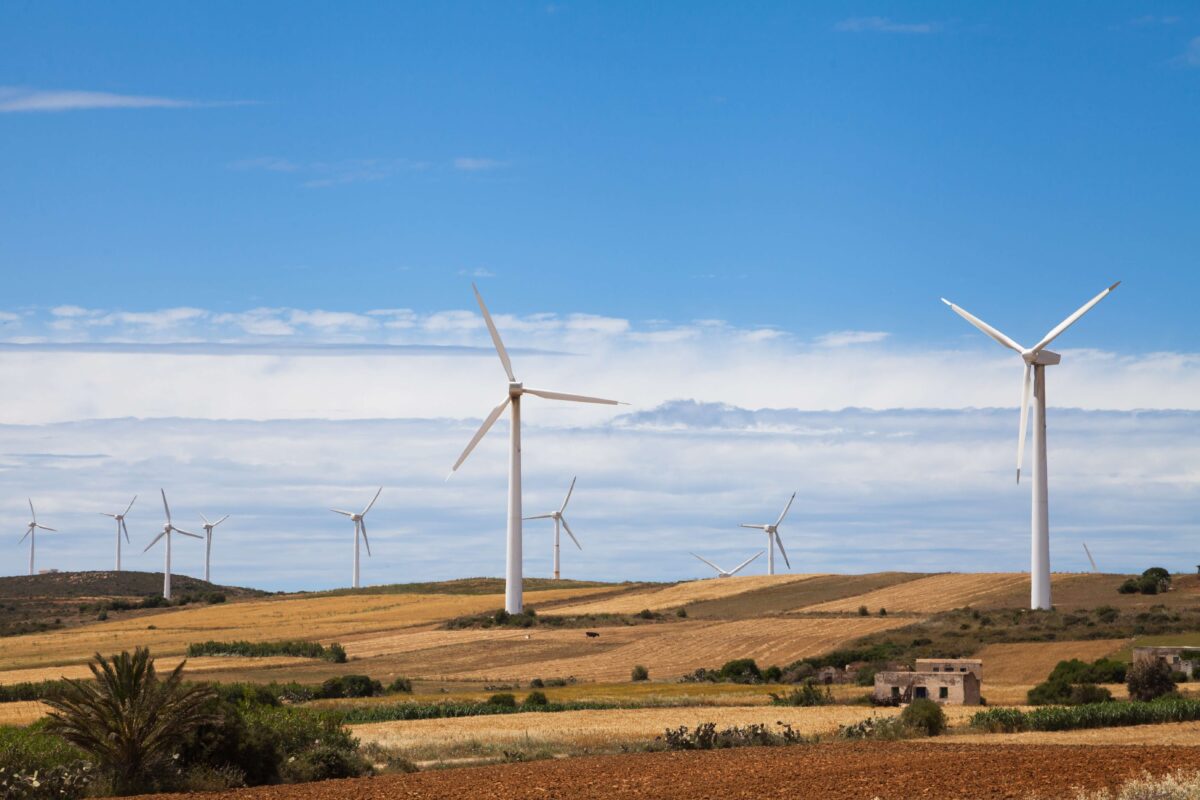Policy is important in driving uptake of renewables
Policy is important in driving uptake of renewables, and this is demonstrated beautifully when looking at the deployment of wind energy in the US, and the lack of resource in the southeast. While some of this boils down to wind resource availability (less windy states are less likely to have installed capacity), there are still plenty of turbines in some less windy states. This is often due to renewable portfolio standards (RPS), which mandate the minimum amount of electricity coming from renewable resources, providing a major incentive to invest in renewables. States without a RPS are typically where there is a lack of wind energy resource, as turbines can be costly to build and less resource means it will take longer to recoup costs: every incentive counts when making a business case to deploy wind. While some less windy states that do have a RPS are meeting it with solar power, other states are buying wind from neighbours where it is more abundant. But the deceasing costs, increasing turbine sizes, and utility knowledge gains around how to best deploy wind are also making the resource more viable. Regardless, we’re unlikely to see an even spread of turbines, which highlights the importance of grid footprint and transmission interconnects when looking at how to reach 100% renewables.
In California, the Energy Commission has recently approved the 2019 Building Energy Code in an effort to meet its mandate of getting 50% of energy from renewables by 2030. The code will require renewable energy access for all new residential homes in the state from 2020, mandating advanced energy efficiency measures and rooftop solar, and incentivising energy storage.
While government can open up renewables deployment through introduction of incentives and mandates, they can also hold up development. The UK government are now being scrutinised over their decision making processes that have resulted in delays over the planned tidal lagoon project for Swansea Bay. Although an independent review undertaken last year urged the government to support the project citing the potential value creation it could bring to the UK’s tidal industry, a decision has yet to be made over whether the project – for which initial discussions began in 2013 – will go-ahead.
Further value could be harnessed by using renewables to generate gas, helping countries decarbonise through using excess generation to create hydrogen. According the the Institution of Mechanical Engineers (IMechE) in their recent report “Energy from gas: Taking a Whole System Approach”, greater deployment of power to gas systems would also help the UK overcome barriers around greater deployment of renewables, and provide a more effective solution to storage than batteries. Jenifer Baxter, lead author of the report, said that government and industry need to step up efforts around investment and demonstration, and urges the government to create an industrial forum to bring together key stakeholders, to use up to 20% hydrogen in the gas distribution networks, and to commission a study comparing long term sustainability of lithium-ion batteries to that of power-to-gas systems and fuel cells.
Corporate policies and decisions are also proving key to driving growth in renewable energy. Last year the global renewable energy capacity purchased by corporations under long-term contracts equalled 5.4GW, surpassing previous records. This shows no sign of stopping for 2018, and transactions that were previously driven by environmental ideals and sustainability targets are now being driven by the bottom line, with cost competitiveness of renewables being used to hedge against rising retail energy costs. Increasingly the corporate renewables market is seeing new options that can be tailored for companies to meet their needs, and this rise in optionality brings new participants of all sizes to the table.
There is a growing interest in grid edge technologies in the agricultural sector, which currently accounts for almost a third of the world’s energy demands and is set to grow significantly over the coming years. It’s become increasingly common to see farmers utilising local energy resources to reduce energy demands, but now there are a growing number of agricultural businesses embracing grid edge technologies and developing microgrids incorporating an agricultural waste fuel mix tied to the farm’s primary business. While examples of these are pretty unique to date, there there are thousands of farms that can replicate such strategies that deliver a value proposition beyond the cost of energy.
Regulatory change
The energy landscape is changing and EY has modelled three tipping points toward a new energy system. The first is when it is as cost-effective to generate and store your own power as it is to buy it from a provider, the second is when EVs reach price and performance parity with traditional cars, and the third is when the cost of delivering electricity exceeds the cost of generating it locally. The timeframes for these in Oceania is 2021, 2025, and 2040 respectively, but in the US the these tipping points will happen at almost the same time. This compressed timeline will mean transformative change, requiring utilities to review enterprise and investment strategies, develop greater digital capabilities, consider collaborations outside the industry, and work with regulators to reshape regulatory models to reward investment in innovative energy solutions.
While new resources and service models including rooftop solar, community choice aggregators and other non-utility sources of energy are paving the way to change, there is the risk that without sufficient planning and a broad perspective on how the grid is evolving, consumers could see electricity prices rises or blackouts. In California, the Public Utilities Commission are taking comments on their paper “California Customer Choice: An Evaluation of Regulatory Framework Options for an Evolving Electricity Market,” which seeks to jumpstart a conversation around grid reliability and a fair and affordable transition, as well as identify whether a single entity is required to set targets, implement, oversee and enforce policies, and how the state can continue to support innovation and deployment.
This is particularly relevant where penetration levels of distributed solar generation approach (or extend beyond) the point where it delivers stress rather than service to the grid, such that the system cannot benefit from additional daytime generation. Consequently, policies to support the growth of solar are no longer tenable, and in many areas have been removed or transformed. Now, policymakers are looking to new rate designs to encourage the growth of solar-plus-storage, and build economies of scale to drive prices down to competitive levels. Rather than incentivising deployment of renewables (the more solar is added the less it’s worth), grid services are being incentivised, for example, in the US through time-of-use rates and three-part rates with demand charges. Alongside this in many states, proposals have been put forward to change rates for homes adopting solar. In a recent white paper put forward by Lynn Jurich, CEO and founder of Sunrun, this “attack” on Net Energy Metering is argued to threaten the stability of the solar business as solar’s “value proposition must be stable to bring investment and innovation into the market.”
Whether this threat will proliferate is unclear, especially in light of the recently published EY Renewable energy country attractiveness index (RECAI), which saw the UK clime into 9th place as its market adapted to subsidy free PV. This is further supported by a statement from Lightsource, the largest European solar developer, that they’re “not putting forward any proposals without storage, currently, to anybody west of the Colorado” as all utilities are are “looking at solar-storage hybrids”.
Regardless, what is clear is that transforming rate design is a crucial element. While the right rate designs can make solar-plus-storage so valuable that utilities will choose it over traditional solutions, leaving the wrong designs in place can hinder vehicle and industrial electrification. Policies need to go beyond the incorrect premise that increasing solar decreases greenhouse gas emissions. Managing solar through co-located storage and other demand management techniques are a critical piece of the puzzle to support en evolving grid and deliver on the global climate fight.
Flexibility and VPPs
Using network assets to deliver value to the grid as well as users can be enabled through a variety of mechanisms. In the UK the Energy Networks Association is exploring this in their Open Networks Project. As part of this large body of work they are considering five different models of smart grid operation, whereby services are procured via aggregators, the transmission system operator, distribution system operators, and/or via an independent actors co-ordinating flexibility (such as peer-to-peer platforms and local energy markets). The impacts of different operating scenarios will be evaluated over the coming year, and used to facilitate a conversation around benefits and limitations of different pathways for the UKs transition to a smarter and more flexible energy system.
Alongside this are many trials and planned works exploring how to best deliver flexibility services under the current regulatory framework. Green utility Ecotricity have announced plans to work with Next Kraftwerke to pool their networked assists into a virtual power plant to meet battery storage and flexibility ambitions.
And Israeli company SolarEdge have unveiled a new virtual power plant platform that will enable customers to aggregate capabilities of their behind the meter storage systems to help resolve local grid issues. The company believes that the system will be many things to many people, and as well as delivering benefits to the grid, it can help retailers manage exposure to peak price and customers gain additional revenue from their assets through managing them in new ways including selling energy and storage services to their peers via blockchain technologies.
Blockchain seems to form the backbone of an increasing number of distributed energy solutions. In Puerto Rico, blockchain provider Power Ledger believes that their technology could have a role to play in helping companies finance microgrid resources and untimely enable them to trade power with other resource owners as well as selling supplies to employees or local communities.
Electric vehicles and the grid
A consortium of major Japanese car manufacturers (Toyota, Nissan, Honda, Panasonic and GS Yuasa) along with the government in Tokyo are working to develop solid-state batteries for next generation electric vehicles, allowing them to drive 550km on one charge (goal for 2025 development) increasing to 800km by 2030. They have launched the Lithium Ion Battery Technology and Evaluation Centre (Libtec) to oversee the 16 billion Yen (122M euros) project funded through the government.
Volvo have teamed up with Vettenfall – a Swedish power company owned by the government – to offer Swedish EV customers the “InCharge Smart Home”. With a goal of developing a well functioning charging infrastructure where their customers live, the charging box helps deliver fast, safe, and smart charging at home. This supports Vattenfall’s new business unit, with plans to become a leading provider of EV charging infrastructure across Europe within the next five years.
But as the number of EVs increase, this puts additional pressure on electricity systems. According to a recent report from Regen, EV electricity demand could total between 25 and 28 TWh per year by 2035 in the UK, and could also put a strain on local electricity networks largely due to the lack of diversity of demand with many EVs being charged for long time periods at similar times of the day. Understanding when and where people charge will be key to mitigate problems, including the development of smarter solutions linked to control systems and price signals such that they operate invisibly and efficiently, without impacting on charging outcomes for customers. To make this happen additional standards and controls will be required such that all all new chargers are able to transmit and receive data and respond to external signals, for example, from network operators issuing commands to EV smart chargers using smart meter communication infrastructure. Finally, access to energy flow data, not just from EVs but from the totality of network demand and generation, will also be critical in order to understand network demand and identify where intervention is required.




